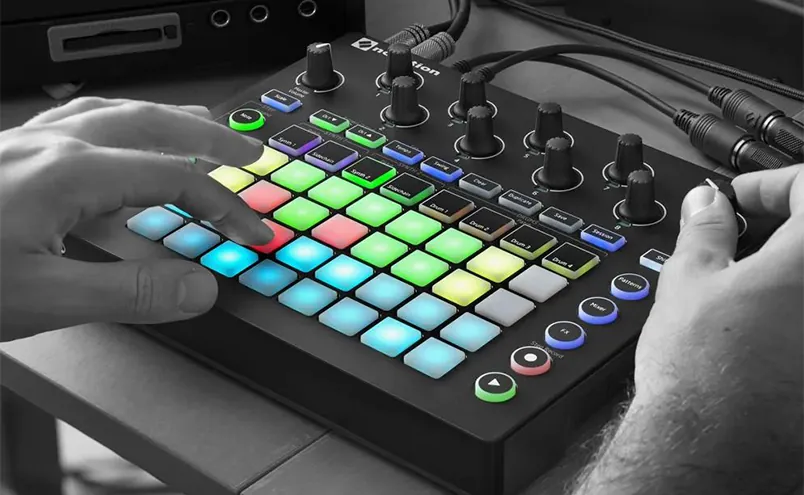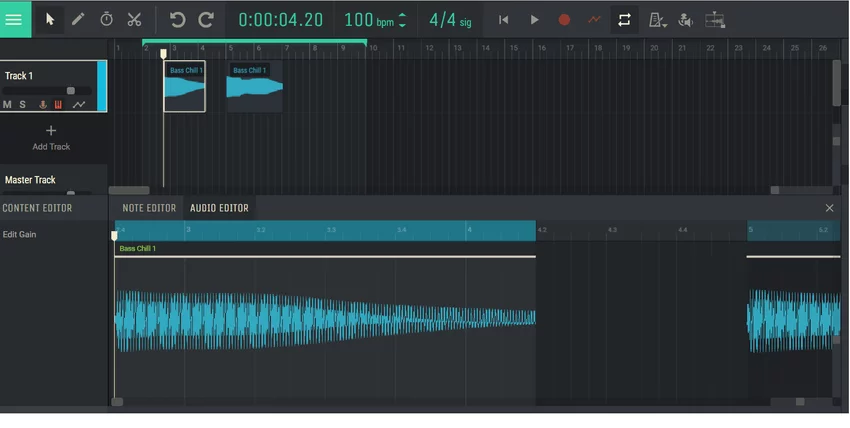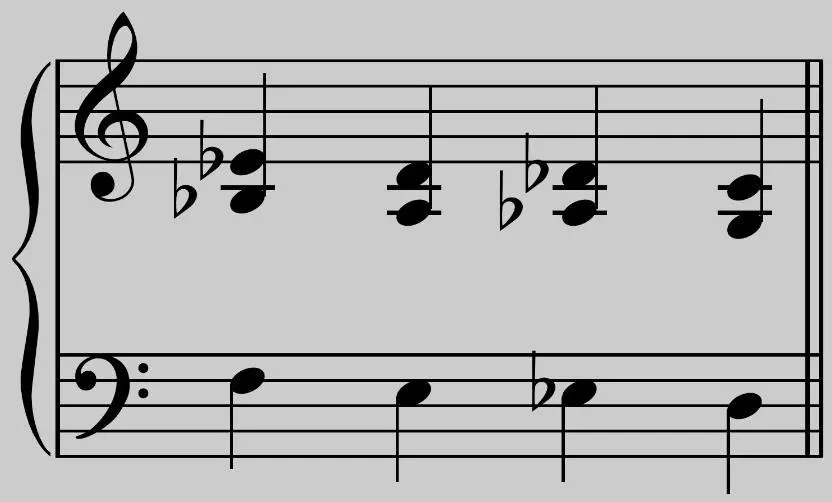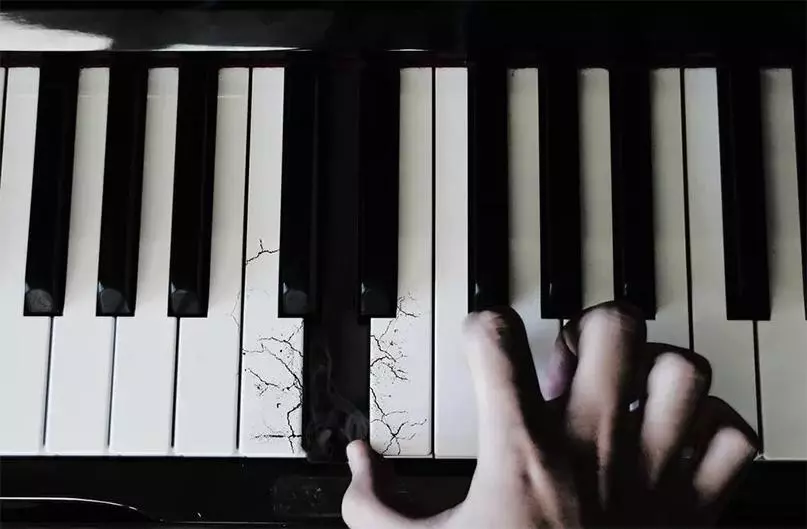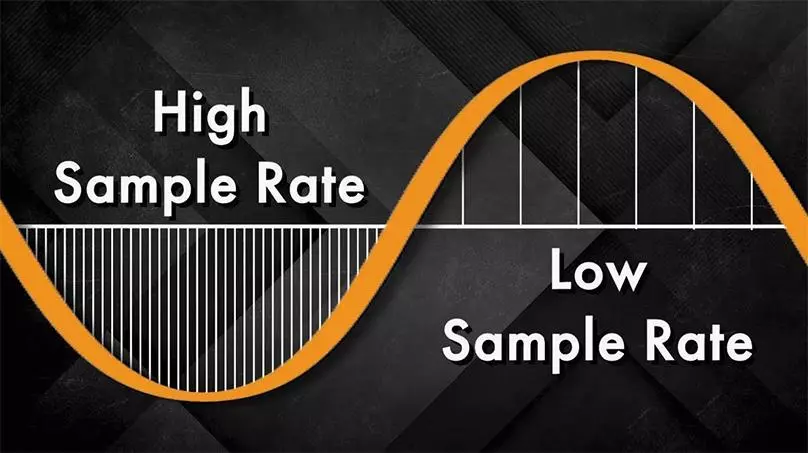The most common chord progressions
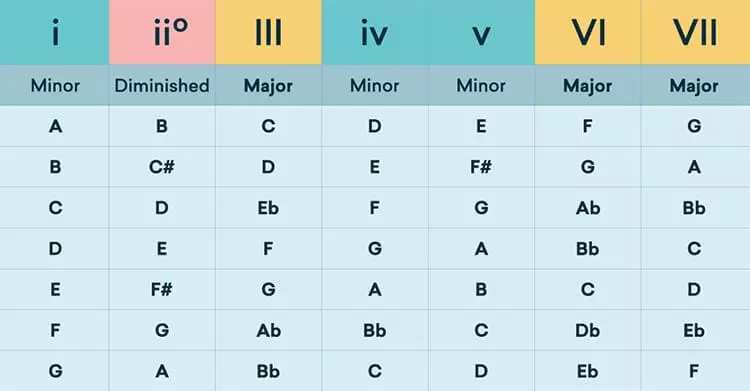
All music is built on a harmonious combination of sounds. Two notes – interval. Three notes is already a chord. When only bass and vocals remain at some point in the song, their lines intersect and also form harmonies. So just two monophonic instruments are enough to create harmony. But richer, more beautiful, more pleasing and more audible textures are woven from chords. Every beginner musician should know at least the most common chord progressions.
You can read how to use the Amped Studio Chord Generator and try to create your own melody online.
Major and minor
Different sound combinations give different colors. The two most common musical moods are major and minor. The first can be described as happy, cheerful, joyful and solemn. The second is sad, thoughtful, serious and melancholic. They are formed by the most common chord progressions, and their characters depend only on the note arrangement.
Two tones, semitone, three tones, semitone is major key. Tone, semitone, two tones, semitone, two tones is minor. For example, in C major, the notes С, D, E, F, G, A, B are located at these intervals. We compose a chord progression only from these sounds to create a sunny mood. If we take D-sharp or G-flat, we get an inharmonious sound.

Gamma in C major
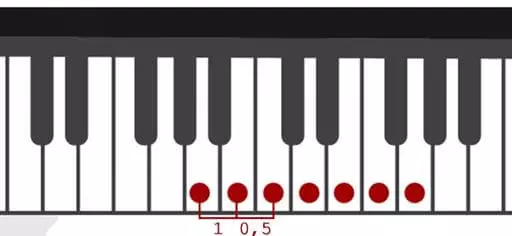
Gamma in A minor
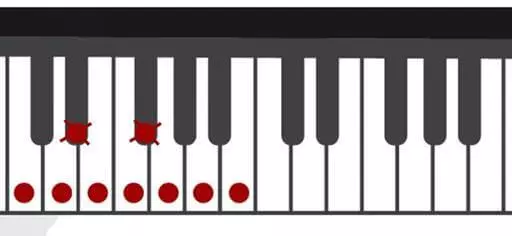
D-sharp and G-flat are not included in the key of C-major
The A minor includes the same С, D, E, F, G, A, B, only in a different order: from A. This means that the chord progressions here will be built on the same triads as in C major. Such keys are called parallel. But one of them represents the light side (major colors), and the other dark. How to create the desired key, if both are the same triads? It all depends on the tonic, the base chord. In C major it is C major (C-E-G), in A minor it is A Minor (A-C-E).
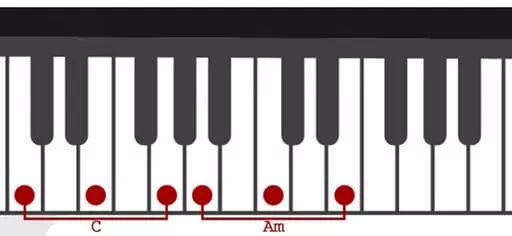
Tonic chords
How to read and notate chord progressions?
Since we have already met with C major and A minor, we will stay with them for now. This includes 7 triads: C major (C), D minor (Dm), E minor (Em), F major (F), G major (G), A minor (Am), reduced B (Bdim). The letter m stands for minor. Dim is a reduced form consisting of two minor thirds. We do not get the usual B or Bm, because that would make D-sharp and F-sharp, but these notes are not in our key.
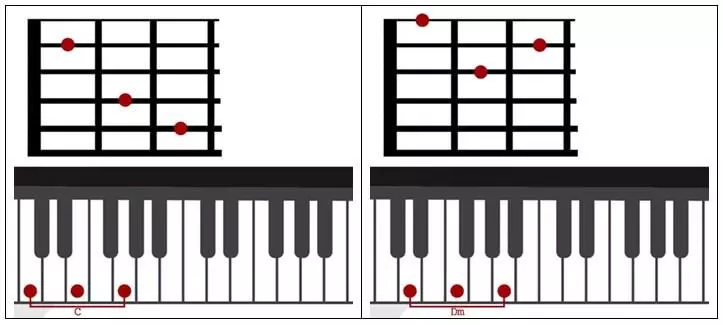
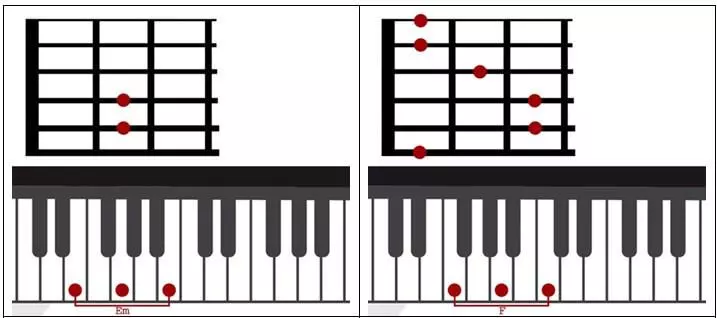

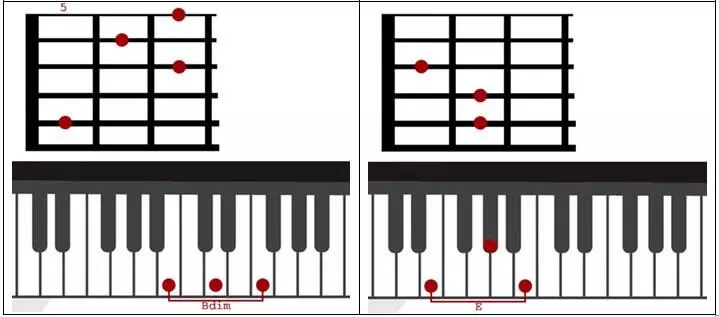
In the most common chord sequences, instead of Em, E is played. This substitution has already become familiar to our ears. It came from a scale called the harmonic minor. E is the fifth step, which gravitates towards the tonic more than others. Although in A minor there is no G-sharp note, it is closer to tonic chord than G, and therefore sounds more intense and creates a more beautiful, logical transition. This can also be taken into account when building your own chord progressions.
The most common chord progressions are Am, C, Dm, E, F, G. But what if the key doesn’t fit? For example, it is uncomfortable for a vocalist to sing in it. Let us take another one. Here is F sharp minor: F#m, A, Bm, C#, D, E. As we can see, the chord structure has changed a lot. But in fact, these are all the same minor and major triads that have the same fingering patterns on the piano keyboard or guitar fretboard. Therefore, for convenience, musicians designate chord progressions not with letters, but with numbers.
- I is tonic chord (in our examples these are C, Am and F#m);
- II – the second step, a triad, which is built from the second note of the scale (Dm, Bdim, G#dim);
- III – third, find the chords yourself according to the same logic;
- IV – subdominant, one of the main steps, it seems to run away from I, sets the movement;
- V – dominant, most of all tends to come to I;
- VI – in the most common chord progressions replaces the subdominant, similar in sound to it;
- VII – and this one looks like a dominant, they have two notes in common.
The VII degree of the minor in the parallel major will become the V (dominant). This means that through it we can make modulation into a parallel key. Let’s say we were playing a dark chord progression, Am-F-Dm-E, but we wanted to change the mood to light. Just modify the last circle: Am-F-Dm-G. And after G, the joyful C-Am-F-G will already sound logical. This is probably the most common and understandable transition to a parallel mode.
Here we have already analyzed the two most common and well-known chord progressions. But before moving on to other examples, let’s make a few remarks.
- By steps, chords can be denoted not only by Roman numerals, but also by Arabic ones: 1, 2, 3, 4, 5, 6, 7.
- In order to understand right away, a minor triad must be set or a major one, the first ones are indicated in small letters (for example, vi), the second – in large letters (for example, VI).
- There is a designation through a slash sometimes: for example, Am / C. This does not mean that you can put either Am or C. It means that we hold Am and the bass note C. On the guitar with the little finger, on the piano with any finger of the left hand.
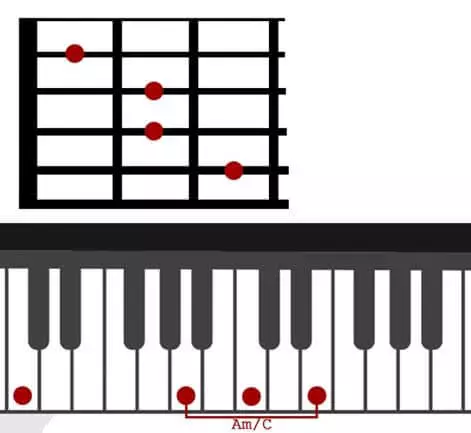
Examples of the most common chord progressions
The skeleton of any harmonic chain consists of tonic, dominant and subdominant, that is, I, V and IV steps. This is the basis that can be supplemented and modified. One of the links can be replaced by II, III, VI or VII. These steps are called side steps. But in a musical context, they still perform a dominant or subdominant function, because they create a similar mood and gravity. Probably the most common and popular chord progression is built on the tonic, subdominant and dominant. There it is.

I-V-vi-IV. It is used both in melodious lyrical songs and in driving punk action movies. We see that it is major: because the main steps in it are indicated by large numbers, they are major. The main movement here is diluted with the sixth step.

I-V-vi-iii. This is also one of the most common chord progressions. It comes from classical music and is usually referred to as the Pachelbel canon. This combination is used in Johann Pachelbel’s “Canon in D Major”.

I-I-I-I-IV-IV-I-I-V-IV-I-I. Do not be afraid of a large number of numbers, in fact, there are only tonic, dominant and subdominant, which are repeated in the prescribed order. This is the most common chord progression for blues improvisation. It is called the 12-bar blues.

I-vi-IV-V. This chain in the 1950s was fixed to another popular genre. It is called doo-wop. Sounds very fun and positive. In general, doo-wop songs are quite enjoyable. Now this direction is used only for retro styling. But the chord progression is also used in new styles.

i-VI-iv-v. One of the most common minor movements. We see here the same steps as in the previous one. Therefore, in terms of the degree of tension and the relationship between the chords, they are similar. But the general mood is quite different. Try to describe it yourself. Here are some more popular combinations for self-analysis.
- I-IV-V
- I-V-VI-IV
- ii-V-I
- vi-IV-I-V
- I-IV-vi-V
Rules for writing chord progressions
Perhaps the most common method of harmonization is playing the melody. Just play the chords that include the notes of the melody. What exactly does it include? The article answers this question. In short: tone. The notes of the melody enter the tone, and all triads from this tone will be appropriate. The most common chord progressions in music are used in this way.
The safest way to build harmony is to rely on the tonic. It is played either at the beginning of the bar or at the end. If the tonic chord does not appear for a long time, the brain begins to take another degree as a basis, and the tonality for hearing changes. By the way, trusting your ears is also important. Music is subjective, and only you determine the degree of beauty and harmony. If you think a chord progression sounds good, just use it and do not be afraid.
Do not know where to start? Listen to the moves that sound in popular songs, world hits and modern works. Look at the analysis, because you have learned to read the notation. Take the chain you like and add or modify it. You can also take the most popular chord progressions that we just reviewed.
So, you have learned what chords and chord progressions are. You understood what intervals major and minor moods lie behind and how to create them with the help of harmony. You learned how to read numerical and alphabetic chains, you saw some of the most common chord progressions. And most importantly, you learned how to build them yourself. It remains to put the knowledge into practice. Do not delay, get started right now.



